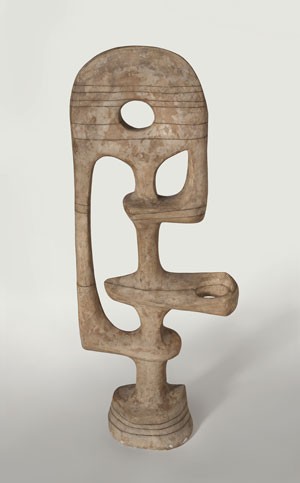Adaline Kent was born in Kentfield, California in 1900. She attended Vassar College and upon graduation she returned to the Bay Area, where she studied for a year (1923-24) with Ralph Stackpole at the California School of Fine Arts (now the San Francisco Art Institute). Stackpole was a leading proponent of the “direct-cut” sculpting method. She then traveled to Paris in 1924 to study at the Academy de la Grand Chaurniere with Emile Antoine Bourdelle, a disciple of and former assistant to Rodin.
Kent returned to San Francisco in 1929 and set up a studio in North Beach. She soon established a reputation as an innovative and original sculptor of great originality, developing an abstract style rooted in surrealism and becoming a prominent member of the San Francisco Art Association. Kent exhibited or juried in the prestigious Annual show nearly every year from 1930 until her death in 1957. She served on the Board of Directors from 1947-57, and taught at the California School of Fine Arts in 1955.
She had her first solo exhibition at the Betty Parsons Gallery in 1949. Kent subsequently showed her work several times in New York, including the 1950 Whitney Annual, an important exhibition at the Museum of Modern Art in New York, and a second solo exhibition at Betty Parsons Gallery. Following a trip in 1953 with her husband, sculptor Robert Howard to Egypt and Greece, her work evolved toward simplified columnar forms.
In 1957 Adaline Kent died in an automobile accident on the Pacific Coast Highway south of Stinson Beach. Her will bequeathed $10,000 to establish an annual award to a promising California artist.
Adaline Kent was very much of her time in every way in none more than the advantage she took of the twentieth century artist’s freedom to find the substance and the reason for creative expression everywhere.
Art of the other times, places and people, curiously formed or colored objects from nature, the inherent qualities and accidental appearances of things and materials, the forms she discovered and those she created, the varied aspects of the world about her, all served her art, and were transmuted, according to her lively fancy and creative need, into a personal statement. She gathered around here, and lived and worked among objects from many parts of the world and things of everyday life and of nature in which her sensitive eye and inventive mind recognized an art quality.
Travel in the mountains of the West and over the stark earth-toned landscape of Greece alike could nourish her imagination and contribute to her creation of new forms. Her work comprehends and expresses all these sources of creative invention, and at the same time remains her alone, completely original and personal.
-Grace L. McCann Morley
Director, san Francisco Museum of Art
From the notebook’s of Adeline Kent
“Sculpture, as any other creative effort, is a document on the thinking of the creator- a piece of autobiography.”
“A piece of sculpture should be a personal experience if not a whole voyage of discovery- discovery of new facets of one’s self.”
“Modern art is the expression of OUR time. It differs from earlier art because of new knowledge. It brings out new horizons. Artists themselves, from the beginning carry a constant, – the need to create a personal truth. As a person lives in his time he must share the ideas that make up that time.”
“The beginning of being an artist is to make yourself worth expressing. Nothing is wasted. You sharpen your personality with every good book you read, every stunning symphony you hear, the rhythms you discover while dancing, every danger you get through, every person you really love, – there’s no end to it. All the time you must be working at the EXPRESSION end of it. You should take notes from nature. You can’t lose anything by knowing how to draw a hand, – one that is alive, not cast, – how to catch and set down, the meaning of a blade of grass or a mountain.”
“An individual artist goes through the transitions of the history of art – classicism to romanticism etc. – swinging toward another as the mood fulfills itself in action – each at his own tempo.”
“I want the power of Stonehenge and the magic of the South Pacific in language of the Wide Present.
To fuse the spiritual with the animal instinct
in forms coherent with nature.
The mystery comes from the strength of
Form-and-Space, not from amorphousness.”



[…] Miller at the Art Students League in New York City. Howard was married to highly successful artist Adeline Kent, from Kentfield, California. He died in […]